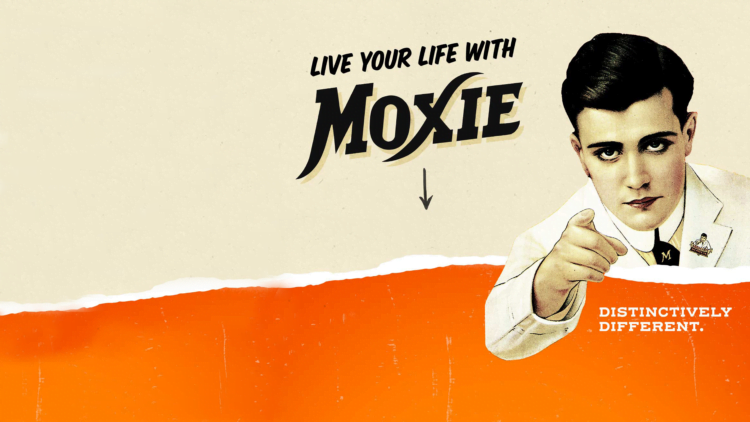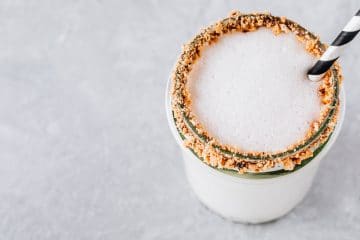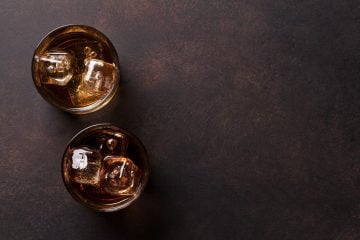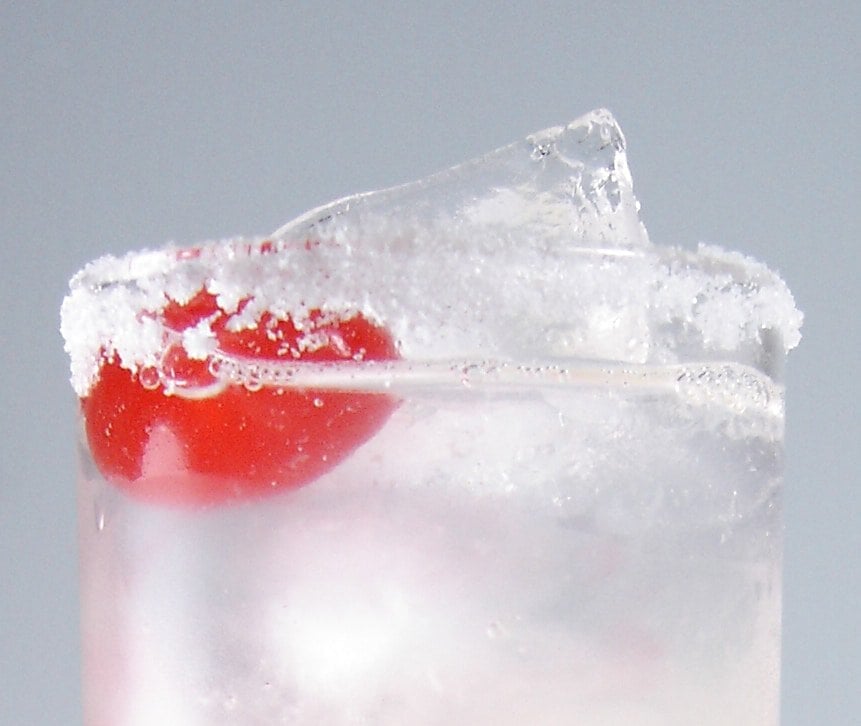Moxie is the official state drink of Maine and is said to be a somewhat acquired taste. Still, for most modern bartenders and cocktail enthusiasts the bitterness of the drink is pleasant and makes for a more interesting soda. If you like Negroni’s, amari, shots of Fernet or dashing cocktail bitters into your drinks, you’ll like Moxie.
Moxie was originally promoted as a cure for dipsomania (alcohol and drug addiction) much like Coca-Cola’s addition of cocaine was done to help opium addicts. The first version of Moxie contained narcotics, though at the time it wasn’t a soda, but a tonic syrup. Early medical journals mention that Moxie contained a combination of strychnine and coca leaf (cocaine). Both of these were viewed as relatively harmless at the time (1880s) compared to opium and alcohol. But both are potently bitter, and that bitterness seems to be Moxie’s calling card. Moxie claimed to be drug and alkaloid free, instead stating a newly discovered plant from South America was key to the benefits.
How do we know this? All the early recipes in pharmacy journals list both coca and strychnine as ingredients. Though these were reverse-engineered by chemists at the time, you are not going to confuse a combination of cocaine and strychnine for anything else. Even in small doses, the effects would be noticeable.
These drugs were used in small doses and that was the key, they had a positive benefit in the short-term that wasn’t excessively obvious, it wasn’t like doing a line of cocaine but it did motivate people and lift their spirits. Low doses of Strychnine give people a subjective feeling of stimulation and it was openly used as a performance-enhancing drug in athletic events. Long term, one drink wouldn’t be enough, then two wouldn’t be enough, etc. Addiction eventually set in.
When Moxie was initially sold there were massive initial sales, probably due to the drugs and this parallels the Coca-Cola story in 1885. Still, there was a backlash from the medical community as Thompson was a homeopath, not a real doctor, and considered a quack and a vendor of quack nostrums. Thompson’s primary initial claim was that Avena Sativa (common oats) was the cure for dipsomania, restoring a shattered nervous system and imparting vigour to the overtaxed brain. Thompson also claimed that a rare, unknown plant from South America, discovered by his friend Lt. Moxie—later changed to Lt. Macksey after being called out that Moxie was an unknown person—was used and the plant was named after Lt. Moxie. This plant never existed and was most likely coca leaf or strychnos toxifera (which contains strychnine), both from South America, both bitter and both flying under the radar of serious drugs at the time.
On a side note, the name Moxie comes from some geographical place names in Maine, that can be found in books before Thompson named his beverage. The word is probably indigenous and means “dark water,” and Moxie does have a dark water appearance.
By 1885, Thompson’s practice had become highly successful and he was said to have one of the largest patient lists in New England. Thompson’s company was bottling 27,000 bottles per week. Coca-Cola’s growth was similar and drug-related. Thompson claimed to have sold 5 million bottles with only $12,000 in advertising by 1886.
It should be noted that the medical community was not a fan of Thompson and his claim that Avena Sativa (common oat tincture) could cure alcoholism, anxiety and assorted other ailments, which led to the medical community analyzing Moxie and discovered alkaloids (coca leaf and strychnine (Bonham)), putting Thompson’s miracle claims into doubt. The Moxie label also claimed, “not to contain any medicine, poison, stimulant or alcohol.” This is the point, somewhere between 1884 and 1886 where Moxie goes from patent medicine to soda beverage sans drugs, though Thompson keeps the name and snake oil claims. Coca-Cola did the same thing later on and we know how that worked out.
The Moxie Claims: “Contains not a drop of Medicine, Poison, Stimulant, or Alcohol. But it is a simple sugarcane-like plant grown near the equator and farther south, which was later accidentally discovered by Lieut. Moxie has proved itself to be the only harmless nerve food known that can recover brain and nervous exhaustion; loss of manhood, imbecility, and helplessness. It has recovered paralysis, softening of the brain, locomotor ataxia, and insanity caused by nervous exhaustion. It gives a durable solid strength, makes you eat voraciously; takes away the tired, sleepy, listless feeling like magic, removes fatigue from mental and physical overwork at once, will not interfere with the action of vegetable medicines.”

 The Medical Era, Volume 6, 1888 on Pg 129 has a story titled “Another Moxie” discussing “Scotch Oats Essence” a product that was marketed as a health tonic but was packed with morphine. The implication is that a previous analysis (Bonham’s) of the Moxie showed it contained strychnine and coca leaf (cocaine).
The Medical Era, Volume 6, 1888 on Pg 129 has a story titled “Another Moxie” discussing “Scotch Oats Essence” a product that was marketed as a health tonic but was packed with morphine. The implication is that a previous analysis (Bonham’s) of the Moxie showed it contained strychnine and coca leaf (cocaine).
In 1886 another round of testing, this time was done by Dr. Francis Wyatt, an analytical chemist, who did the work for American Analyst (a journal dedicated to industrial progress, sanitation and the chemistry of commercial products), which in today’s terms was the Myth Busters team of the era, they used science to debunk snake oil and patent medicine claims. They were held in high esteem by the medical community.
Dr. Wyatt’s analysis of Moxie Soda deemed it as follows:
“The sole property to which this mixture can lay claim is that of a mild and entirely inoffensive tonic, forming an agreeable drink for quenching the thirst and incapable of exercising the slightest action upon the brain or the nervous system.” As the kids say “burn.”
Thompson did not like this review of his product and threatened to sue the American Analyst, though I don’t find anything in the history books showing a lawsuit being pursued. The problem for Thompson, and Moxie, was that at one time he lied about being drug-free, when in fact it did have narcotics, then he removed the drugs, kept the claims and got called out again.

In another burn, a Western Druggist (1888) editorial comment regarding a letter Thompson sent to Western Druggist stated:
“As a decoction of oats, flavoured with sassafras and wintergreen “Moxie” is certainly harmless enough, though the modest little oat must feel considerably amused over being “discovered” in South America by a gay** lieutenant, and at once set as a blazing sun in the medical heavens. Its eminent sponsor’s defence in the above refined and scholarly production must make it the merrier”. —Ed. W.D. ** In this time period this just meant carefree, not as a slur
And another:

The Doctor 1886
There are multiple back-and-forth letters published between Thompson and the medical industry. The medical community seems to joyfully celebrate calling out Thompson and Moxie, though I believe Thompson got the last laugh because Moxie is still being sold today.
Moxie isn’t a cola, it’s more akin to a root beer, just a bitter one. When the drugs were removed the bitterness was replaced initially with cinchona (quinine) and eventually gentian, though the current label also adds caffeine, which contributes to the bitterness. Fact, the addition of caffeine to beverages is not for alertness, it is a bitter flavouring. An alertness claim needs to be printed on the label if caffeine is not used as a flavour.
As noted above, the medicinal properties of Moxie were attributed to Avena Sativa (common oats) not gentian as most people believe today.
The actual aroma of Moxie is wintergreen, though early on it was used in combination with sassafras however the FDA banned its use in the 1960s and had to be removed. Some recipes from the late 1800s use sarsaparilla. Moxie is basically a root beer with a bitter finish, not particularly complicated, but the product has a long and interesting history.
You will see it written that at one time Moxies was more popular than Coca-Cola, up until 1920, this simply is not true. The number of bottling plants Coca-Cola employed seriously outnumbers anything Moxie ever did. You can find bottler information in periodicals from the time.
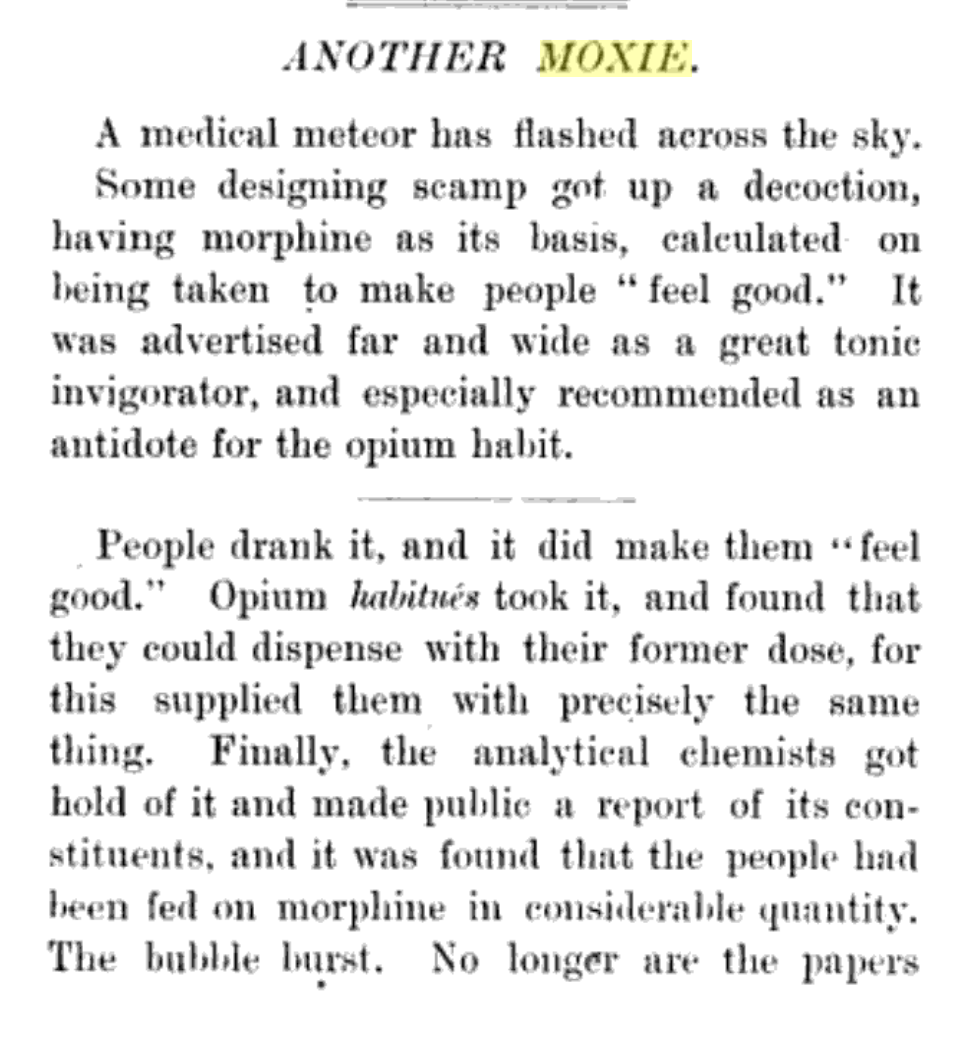
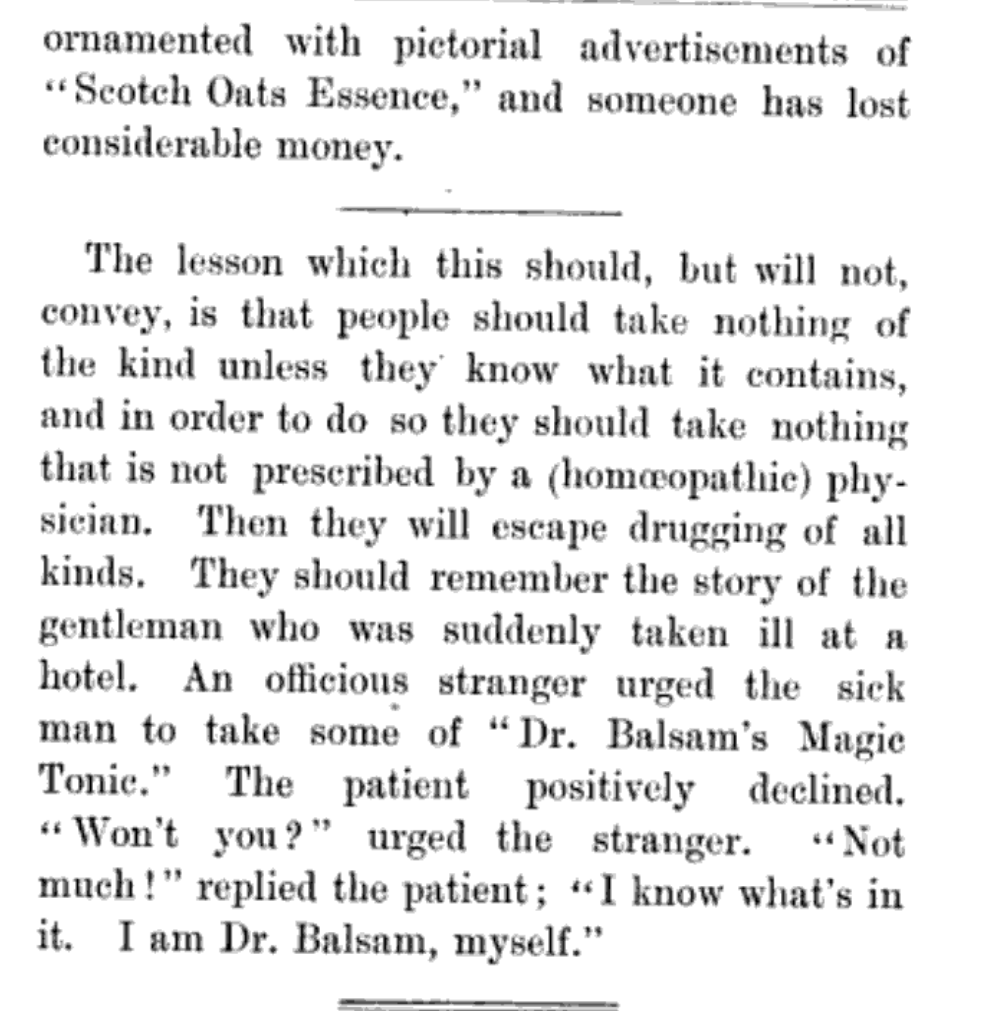
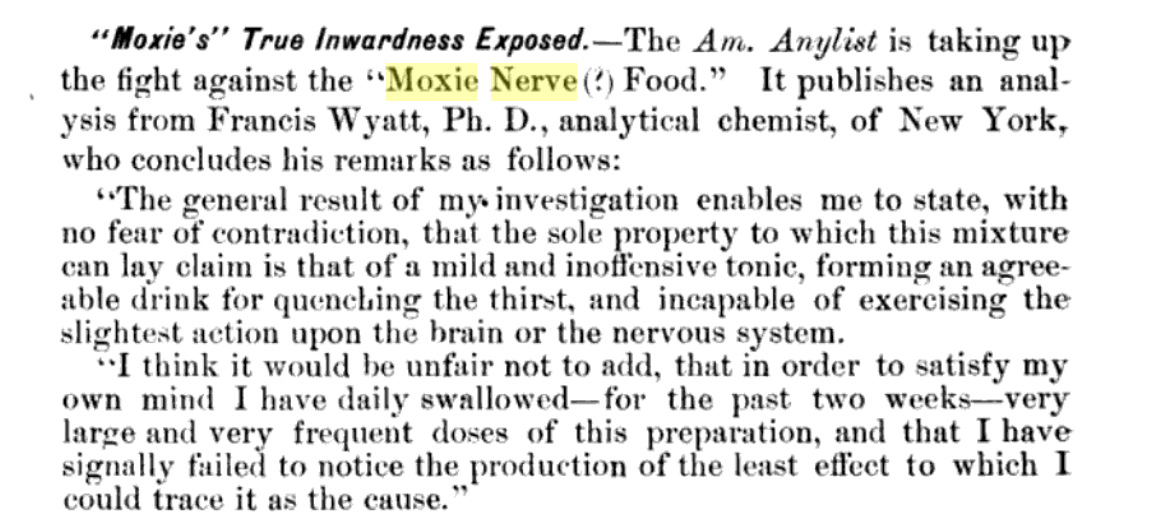
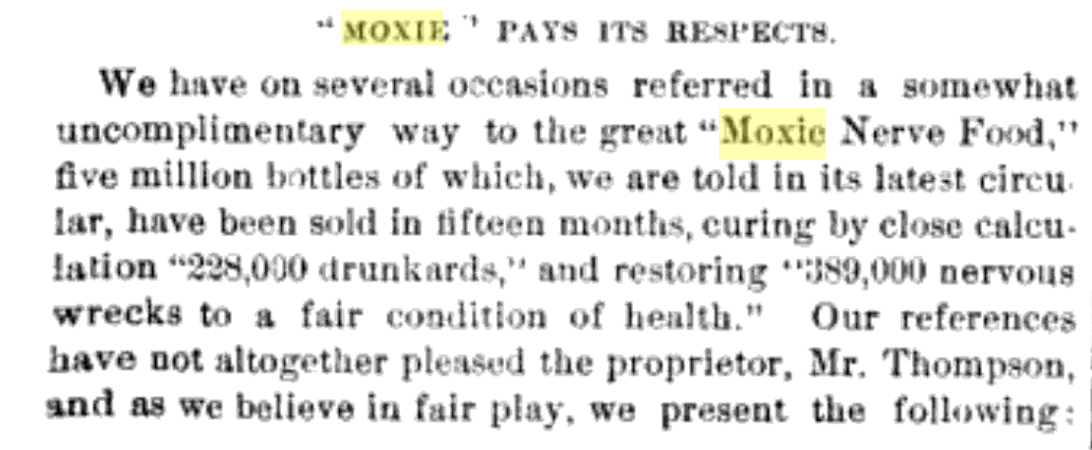
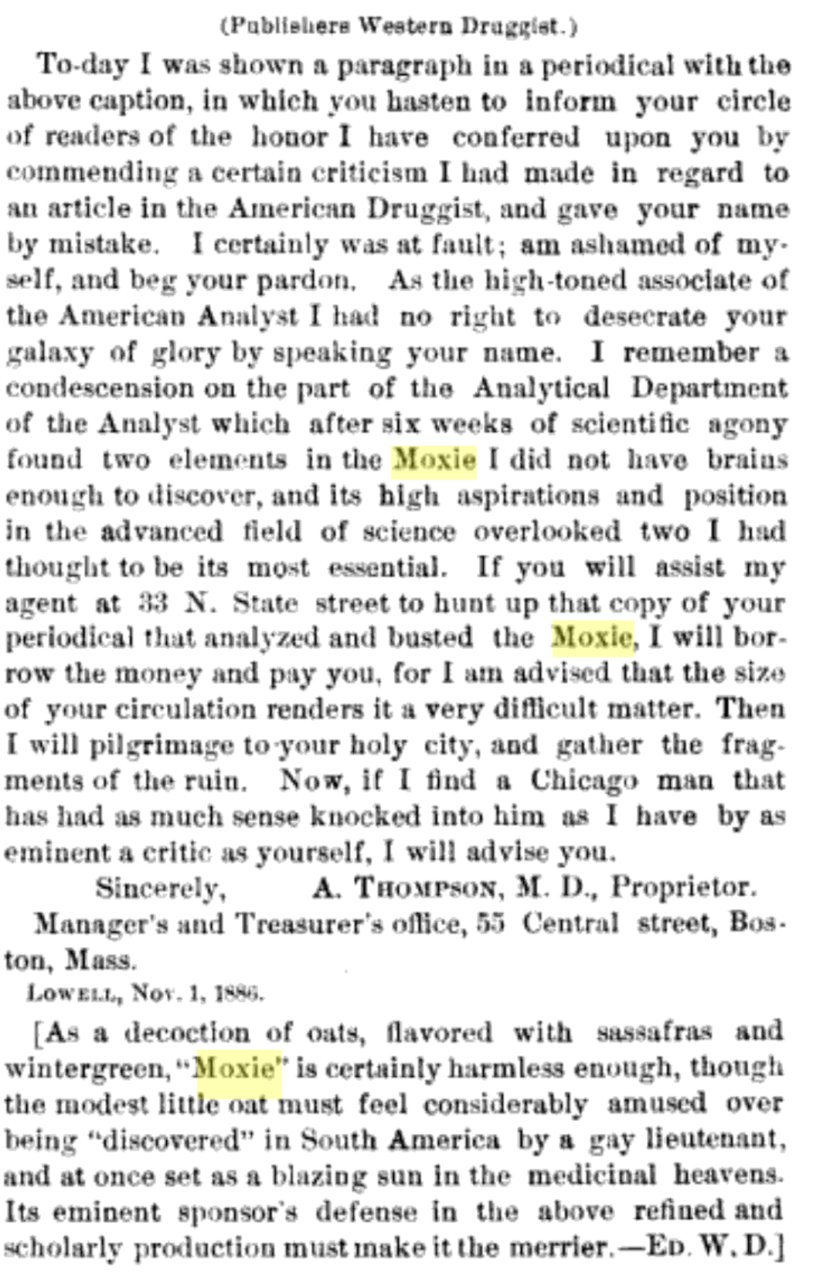
How to Make Moxie Syrup
This is a fairly simple recipe, though you will need to prepare some of the ingredients. For instructions on making the essence and extract, please watch the video above, they are standard soda fountain techniques, but it is important that you do not use pure wintergreen oil, you must make a wintergreen essence first.
15 ml Gentian Extract
15 ml Wintergreen Essence
2 ml Anise Essence
30 ml Caramel
1.0 grams Caffeine (optional)
900 ml Soda Syrup
Mix all of the above ingredients thoroughly in a bottle with the simple syrup. You may want to add a small amount of water to the caffeine powder to help disperse it and remove clumps.

